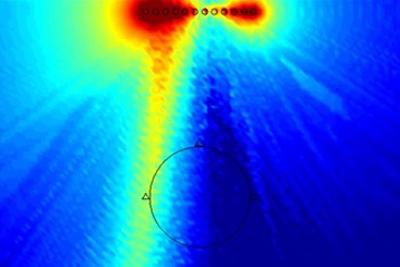Brief description
The loudspeaker array technology developed at the ISVR has paved the way to revolutionise the way people enjoy audio, at home and on the move.


Explore this case study
The challenge
3D and immersive audio are words that we hear with increasing frequency in the context of sound reproduction. Indeed, existing state-of-the-art audio systems are not only required to deliver the sound of our favourite singer with impeccable quality, but are also expected to provide us with the illusion that the sound of that comes from our left, from behind us, or from above. Stimulated also by the rise of Virtual and Augmented Reality, recent technological advances in spatial audio have led to the development of surround sound systems, object-based audio formats, and 3D audio over headphones.
These systems, however, still suffer from many limitations, which generate challenging research questions. For example, is it possible to deliver 3D audio without surrounding the listener with loudspeakers? And is it possible to ensure a consistent audio quality even when the listener moves out of the so-called sweet spot, that is the listening position for which the audio system has been optimised? And again, can audio delivery be optimised based on the preferences of different listeners that share the same environment, or even completely different audio material be delivered to multiple listeners?
What we do
Research at the Institute of Sound and Vibration Research (ISVR) has led to the development of innovative loudspeaker array technologies that have the potential to revolutionise the way audio is delivered. An array is a collection of multiple loudspeakers, each of which is controlled independently to reproduce a signal that is apparently identical to the signals generated by the other transducers, but its phase and magnitude are in fact different and carefully designed.
Based on the same constructive and destructive wave interference principle that underpins the active control of sound, loudspeaker arrays perform a ‘spatial synthesis’ of sound, creating sound fields that could not be generated with conventional audio systems. These loudspeaker arrays can, for example, deliver a given sound signal to one listener and a different signal to another in a second position, enabling people to simultaneously hear speech for a video in different languages.
Furthermore, ISVR researchers have applied ‘beamforming’, a technique widely used in antenna and sonars, to create sharp beams of sound that deliver independent signals to the two ears of a listener, thus achieving a 3D audio effect without wearing headphones. Southampton researchers have combined 3D audio with computer vision to create a system that tracks the position of the listener using a digital camera and adapts the audio DSP algorithm. In this way, the reproduced signal is always optimised for the current position of the listener so that the concept of ‘sweet spot’ will soon become a thing of the past.
Our impact
Most of our research in audio technology has been carried out in collaboration with industrial partners. This has proved to be a fast route to impact for our scientific findings. For example, our work with the BBC has informed the creation of international standards (e.g. ITU-R BS.2127) and has provided audio producers with new way of telling stories with sound. Our collaboration with Huawei has created a new technology to synthesise sound fields with cylindrical or hemi-cylindrical smart speakers. Our knowledge of psychoacoustic phenomena supported the renowned car-audio manufacturer ASK Industries to further improve the performance of their independent listening zones in the interior of a car.
Furthermore, ISVR research has led to the creation of technologies from two start-up companies: Optimal Source Distribution technology developed by Opsodis to deliver 3D audio with a single sound bar; and Audioscenic systems equipped with a camera to track listeners and allow for a consistent 3D audio experience.
The facilities we used and partners we work with
Our research work was carried out in our world-leading acoustics and audio research facilities, including the ISVR’s anechoic chamber, one of the largest research facilities of its kind in the country, our listening room and our Audio Laboratory equipped with a large distributed array of loudspeakers.
We also used the University’s 3D-printing facilities and electronics workshop to create loudspeaker array prototypes.
Key Publications and media
Publications:
- Hamdan & Fazi, A modal analysis of multichannel crosstalk cancellation systems and their relationship to amplitude panning. Journal of Sound and Vibration - https://doi.org/10.1016/j.jsv.2020.115743
- Franck et al., A system architecture for semantically informed rendering of object-based audio. Journal of the Audio Engineering Society. https://doi.org/10.17743/jaes.2019.0025
- Hoffmann et al., An analytical model for wedge-shaped acoustic arrays. Journal of Sound and Vibration. https://doi.org/10.1016/j.jsv.2018.09.041
- Simon Galvez et al., Dynamic audio reproduction with linear loudspeaker arrays. Journal of the Audio Engineering Society. https://doi.org/10.17743/jaes.2019.0007
- Menzies & Fazi, Multichannel compensated amplitude panning, an adaptive object-based reproduction method. Journal of the Audio Engineering Society. https://doi.org/10.17743/jaes.2019.0029
- Olivieri et al. Generation of private sound with a circular loudspeaker array and the Weighted Pressure Matching method. IEEE/ACM Transactions on Audio, Speech, and Language Processing. https://doi.org/10.1109/TASLP.2017.2700945
- Takeuchi & Nelson, Optimal source distribution for binaural synthesis over loudspeakers. Journal of the Acoustical Society of America. https://doi.org/10.1121/1.1513363
Videos:
- https://www.youtube.com/watch?v=QTQmlJz_RPc&list=PLhDguovu3QRMN3JqqbmDTCryfUn1pjaHK – creating private listening zones in 360
- https://www.youtube.com/watch?v=x6_t2gnDhpY: virtual tour of our research facilities with audio technology demonstrations
Links to external websites
Related Staff Member
Related Staff Member
Researchers and PhD students





